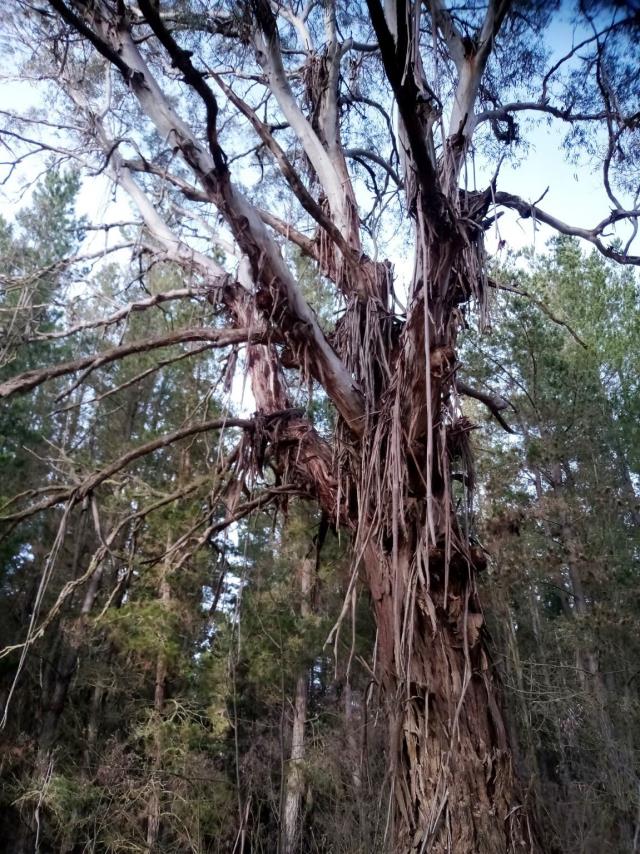By Beatrice Hawkins
As I drive around this southern area of NSW I have seen a species of eucalypt I hadn’t notice previously. As I looked it up I have found that it is commonly called “ribbon gum” because of the way it sheds its bark.
Long “ribbons” of bark fall from the tree and are caught in the branches and collect there high up in the canopy as well as all the way down.
Maybe that’s why many of the trees in the fire area have been burnt so badly. Not only was there a huge body of fuel at ground level, there was also fuel all the way up to near the tops of the trees. In dense stands of trees the fire would very quickly spread from tree to tree via these natural, very dry, bark collections.
*This is an old article that has been digitised so our readers have access to our full catalogue.
As we know, fire does spread rapidly through eucalypt forest because of the oil content, add this large bark fuel source as well and a real recipe for disaster is there. I am told by the locals that these collections of bark ignite like a torch and burn fiercely as the fire goes through.
There are many common names for this medium to large tree. White gum, for its flowers and bark, manna gum, as it was used for honey, gum and medicinal purposes by indigenous people, mountain gum, for where it grows, snow gum and many more. It is very different to the snow gum that I know as it is a tall erect tree rather than the lower growing, many branched, weather beaten tree that you typically see in the snow areas.
The botanical name is eucalyptus viminalis and I am reliably informed by the locals that it is not a good fencing timber, as it rots quickly in the ground, and also that it is not a good timber for firewood. It is used for flooring, joinery and cabinetry and as wood pulp. It is, however, a decorative addition to the landscape among the other trees!
Another of my favourite shrubs and one I have had in a couple of the cold climate gardens I have enjoyed as we shifted around, is the lilac.
I have enjoyed the perfume and the colour of this lovely shrub as both a single and double, white, deep purple and the more common pale mauve or “lilac”. It is one of the first shrubs to flower and a real harbinger of spring. They are frost and drought hardy once established and like full sun but will tolerate part shade at the expense of flowers. Good, well drained, garden soil will keep them happy and pruning after flowering will ensure an abundance of blooms the following season as they flower on old wood. Too much fertiliser in the winter may cause them to have less flowers in spring.
Interestingly, they are a member of the olive family and are now native to the scrub from Southeaster Europe to eastern Asia, but may have been brought to Europe by the Ottomans. They were named by the famed Swedish botanist Carl Linnaeus in the 18th Century. The genus name, Syringa Vulgaris, is a mixture of two languages. Syringa from the Greek word for pipe or tube and vulgaris from the Latin meaning “common”.
They are available these days, thanks to our plant breeders, in a wide range of colours and sizes to suit most situations. Japanese lilac appears to be the tallest growing while Korean lilac is a dwarf form. Colours vary from white through pinks, deep purples and magenta depending on what you choose, and flowers as either a single or double form.
Lilacs can be grown from seed and while this is not a particularly complicated procedure, it may take several years for these seedlings to flower. If you really are keen to germinate some seeds you will need a fair amount of time. Firstly, soak the seeds for at least 12 hours. Then put them in a bag with some perlite and refrigerate them for a couple of months to imitate winter! Following this chilling, plant them into some seed raising mix, put them somewhere where the temperature will be fairly constant and after about a month or so your seedlings may appear.
Sorry, this is too time-consuming for this gardener, especially as I would then potentially have to wait several years for the shrub to flower! I think I’ll just go visit my favourite nursery and by an already established plant.
Don’t forget your gardens in the winter and have them ready for the annual garden competition in October, along with entries in the Spring Flower Show and designs ready for the decorated window displays for Rodeo weekend… all things to look forward to and keep us occupied.







